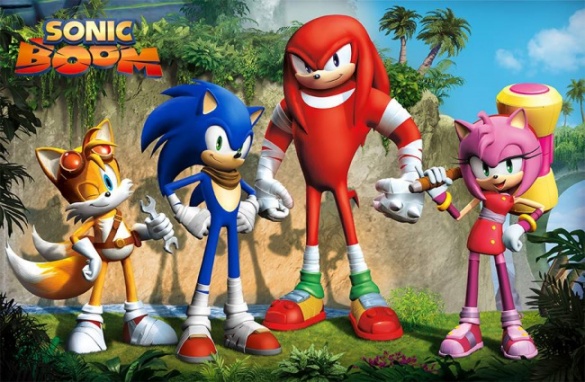Remember Sonic?
Of course you do! Born in 1991 as Sega’s answer to Nintendo’s Mario, Sonic quickly became a system seller and one of the most iconic video games characters. As a matter of fact, he was one of the first members of the Walk of Game, alongside Mario and Link.

Original Sonic
Since Sega abandoned the hardware business, its mascot jumped to other platforms, increasing its fame (even if the last games were poorly received). Ironically, in May 2013 Sega announced a partnership with Nintendo, so the next 3 Sonic games will be developed exclusively for the 3DS and Wii U, being Sonic Lost World the first. Following that deal with Nintendo, Sega has been busy doing a total makeover on its flagship character, and the result is Sonic Boom.
Sonic BOOM!
In a clear move to change the franchise’s appeal to Western audiences, Sonic Boom will be developed by American studios: Los Angeles-based studio Big Red Button for Wii U and San Francisco-based studio Sanzaru Games for 3DS. Both of them will be focused on combat and exploration, but with slightly different content (mostly environments and enemies).
“One last thing”
But don’t be confused. If Sega hosted a press event in New York wasn’t just for announcing a new installment in the decades-old franchise. No, Sonic Boom is a whole new universe for the blue hedgehog, comprising 2 games (3DS and Wii U), a toy line and an animated Cartoon Network TV series (with 52 11-minute episodes). The Sonic Boom characters will exist in parallel with the original ones without replacing them.
The business reason behind the “cross-media” launch is to cover as many obvious, and follows the same strategy a lot of other properties have had: to cover , being The Simpsons a clear example (even South Park is investing heavily on its long-awaited The Stick of Truth).
The artistic redesign, in turn, seems to focus on each character’s skillset: Sonic’s legs (because he runs), Knuckles’ upper body (because ha can throw a punch), Tails’ wrench (because his tails are evident) and Amy’s hammer (because… well, I guess she’ll use it). The blue hedgehog’s new scarf is a different case, and it may have to do with Uncharted Nathan Drake’s influence.
Fast feedback
Of course, this deep makeover didn’t go unnoticed for fans and the Internet community in general. Some elements like Sonic’s scarf, bandages and long legs (along with Knuckles’ new passion for the gym) have become the center of many jokes. Here are some of them:

Sonic loves bandages
What do you think of Sonic’s new look?







